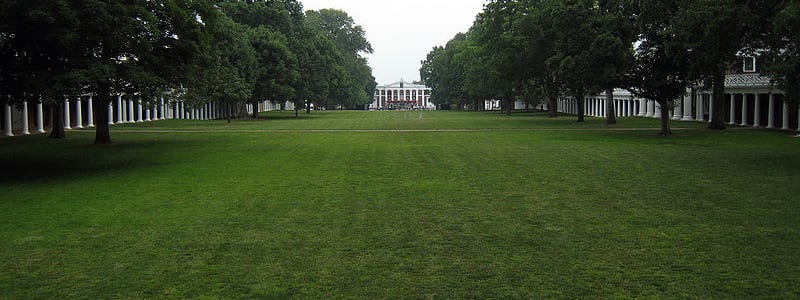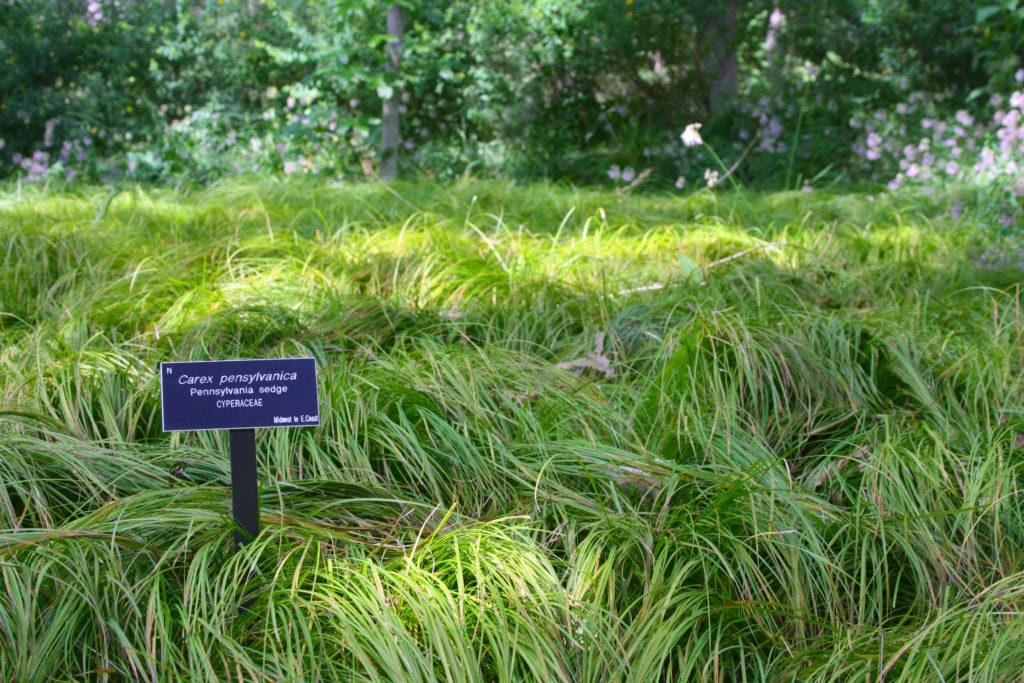by Mark Richardson
This article was reprinted with permission from Native Plant News (Spr-Sum 2017), the member magazine of New England Wild Flower Society.
Pristine turf grass lawns are as synonymous with America as baseball and apple pie. For those of us who grew up in the suburbs, waking up to the lulling drone of lawnmowers signaled the start of a summer Saturday with all of its anticipated pleasures. I’ve yet to meet a person who doesn’t enjoy the smell of fresh-cut grass. And deep down, even those of us who are staunchly anti-herbicide harbor a secret hatred of dandelions, if only for the glares they evoke from our neighbors: Do they think I’m lazy? Or letting my property go downhill?
 Yet despite what Scotts®, Bayer, TruGreen®, and other corporations in the so-called green industry would have us think, lawns are far from green, environmentally speaking. (They’re not American, either.) We’ve known for decades about the harm lawns cause, but we are still mowing and blowing: Irrigated turf grass covers nearly two percent of the land in the United States, more than 40 million acres. Every square inch of it replaces diverse habitat for wildlife with a monoculture of nonnative plants, and we keep it going with fossil fuels and chemicals toxic to most living things.
Yet despite what Scotts®, Bayer, TruGreen®, and other corporations in the so-called green industry would have us think, lawns are far from green, environmentally speaking. (They’re not American, either.) We’ve known for decades about the harm lawns cause, but we are still mowing and blowing: Irrigated turf grass covers nearly two percent of the land in the United States, more than 40 million acres. Every square inch of it replaces diverse habitat for wildlife with a monoculture of nonnative plants, and we keep it going with fossil fuels and chemicals toxic to most living things.
How Did We Get Here?
Perhaps our addiction to the lawn’s visual appeal persuades us to overlook the hazards of maintaining it. But it’s time we got serious about kicking this habit. Besides, when we consider the diversity of natural habitats and gorgeous native plants across the United States, it seems a shame that our signature cultural landscape relies on plants that are finicky – and, frankly, boring.

Our lawns include grasses given American-sounding names, but they are not native to the U.S. Kentucky bluegrass, for example, is native to Europe and parts of Asia.
The trouble with lawns starts with the grass itself. Although some have American-sounding names like Kentucky bluegrass, most of the turf-grass species we plant in the United States are native to Europe. As a result, they are often poorly adapted to our climates and soils – especially the acid soils of New England – and must be kept on life support: only with supplemental irrigation, fertilizers, herbicides, and pesticides does the grass stay green and grow all summer. When it grows too high, which happens quickly because of the added water and fertilizer, we cut it.
Most people do their lawn cutting with a gas-burning mower trailing fumes that catalyze into ozone pollution in the summer heat. For those too busy to maintain their lawns themselves, multiple businesses compete to take it on. According to Bloomberg News, we spend, on average, more than $40 billion per year on lawn care – $3.5 billion more than the federal government’s 2017 budget for foreign aid. ScottsMiracle-Gro, one of the largest beneficiaries of that spending, generates roughly $3 billion in annual sales revenue from products like Turf Builder® Weed & Feed.

Use of pesticides and herbicides on lawns threatens rare species such as the regal fritillary (Speyeria idalia) and the plants that support them. Photo: England Wild Flower Society
Our Reliance on Chemicals
Consider the quantity of pesticides applied in the name of keeping grass green each year: 30,000 tons annually, according to the U.S. Environmental Protection Agency (EPA). The University of Massachusetts reports that the typical lawn-service company in that state applies five to seven pounds of pesticides per acre of lawn a year. Per EPA records, this is at least twice the amount applied to the most pest-plagued of agricultural crops, sweet corn. That is staggering – and terrifying – because lawns serve as the primary play space for our kids and pets. Fourteen of the 30 most commonly used lawn pesticides are neurotoxins are known or suspected carcinogens, and two-thirds of them may cause reproductive harm in humans. Not to mention the fact that many of the chemicals we dump on our lawns are herbicides meant to kill “weeds” that potentially offer benefits. Clover, for example, fixes nitrogen that can support turf-grass growth. Violets can host rare butterflies like the regal fritillary. Despite labels that tell us these products are safe for use around children and pets, ongoing scientific studies find many of them are anything but, which means we need to act accordingly – and to the alarm of the landscape services industry we are starting to do it.

Some states have begun issuing new regulations on the application of fertilizer in order to reduce water pollution. Photo: Pexel
Over the last five years, for instance, many states have passed regulations to reign in a major source of surface-water pollution: lawn fertilizers, which feed the grass with varying combinations of nitrogen, phosphorus, and potassium. The EPA reports that nutrient pollution is “one of America’s most widespread, costly and challenging environmental problems, and is caused by excess nitrogen and phosphorus in the air and water.” Four of the six New England states now have regulations that limit the types and amounts of fertilizer that can be applied to lawns. The rules restrict fertilizer use for all non-agricultural turf grass, from residential neighborhoods to strip malls and public parks.
What’s the Alternative?
Regulating which chemicals can be sold and how to apply them is important. But to let go of the lawn, we need to replace it with a landscape that supports wildlife, looks beautiful, and is relatively easy to maintain. This is where homeowners sometimes balk. When I lead workshops about planting to replace lawns, I hear the same concerns time after time: “I don’t know what to plant.” “I don’t have time to pick out plants or learn which one goes where.” “I’m not a designer – what if my yard looks awful?”

Although neighbors may question your choices, an alternative lawn can be attractive to both wildlife and humans. Photo: England Wild Flower Society
My first response to questions like these is, “Be prepared for your neighbors to glare at you.” Ironically, the peer pressure of maintaining pristine turf grass limits our freedom to express ourselves in our most personal spaces. Who knows: maybe those disapproving looks will prompt constructive conversations about why you chose to limit your lawn? (Or you could announce to your scowling neighbor, “Your lawn is killing us!”) Choosing what to plant can be as simple as picking a paint color. Start slowly – don’t tackle your whole lawn all at once. Sort areas of your yard into three categories:
1) Where could you lose the lawn and not miss it?
2) Where do you desire a green groundcover, but not necessarily turf grass, for aesthetic reasons?
3) Where is a lawn of some sort useful, say, for kicking around a soccer ball or stretching out to read a book?
Now, work backward.
In Category 3 places, keep the lawn, but get off the weed-and-feed cycle. Mow high – between three and four inches – with a mulching mower and aerate your soil in the fall. Keep in mind that the longer your grass, the deeper its root system and the less irrigation it will need. Replace thirsty grasses with drought-tolerant species like tall fescue (Festuca arundinacea). In short, manage what lawn you have to limit the impact on the environment, kids, and pets.

Wild strawberry (Fragaria virginiana) is a low-growing perennial that can provides sturdy and attractive ground cover in sunny locations. Photo: England Wild Flower Society
In Category 2 places, consider site conditions – sun exposure, moisture, and drainage. Now look for mat-forming perennial groundcovers, or true lawn alternatives, that thrive in your conditions. If you have a sunny spot, one of my favorites is wild strawberry (Fragaria virginiana), a semi-evergreen, mat-forming perennial that tolerates a wide range of conditions and does best in full sun. It’s a great plant for pollinators, supporting dozens of moth and butterfly species, and it bears tasty, fragrant little strawberries in mid-June. In shadier spots, consider Pennsylvania sedge (Carex pensylvanica). At Garden in the Woods, we have a sedge lawn that we mow once a year after the flush of spring growth. It looks much like standard turf grass the rest of the year. All of these groundcovers are lower maintenance than turf grass, requiring no fertilizer, very little if any supplemental watering and a minimum of other care

Foamflower (Tiarella cordifolia) offers good ground coverage in shady areas that do not see much foot traffic. Photo: England Wild Flower Society
In Category 1 places, again consider site conditions, then visit a garden center or a public garden to look for inspiration. Take photos as notes. Choose a color palette and find some plant combinations that complement each other and grow well in similar conditions. One of my favorite combinations of groundcover perennials for spring color in a shady spot is creeping phlox (Phlox stolonifera) and foamflower (Tiarella cordifolia). They flower at the same time and work as living mulches that stabilize soil and keep weeds at bay. Layer in some taller accent plants, such as a native flowering shrub or two that fit your color scheme and conditions and you’ve got the start of a beautiful, low-maintenance garden that will provide a spot of native habitat for you and your family – and turn your lawn into an urban oasis for wildlife.
About the Author
Mark Richardson oversees the New England Wild Flower Society’s botanic garden, Garden in the Woods, and its native plant nursery operation, Nasami Farm in Whately, Massachusetts. He studied ornamental horticulture at University of Rhode Island and helped run a mid-sized ornamental plant nursery before finding his true passion in public horticulture. He led undergraduate programs at Longwood Gardens, overhauled the curriculum of the Professional Gardener Program, and oversaw adult education at Brookside Gardens. In 2013, Mr. Richardson assisted with the development of the first comprehensive master plan for Garden in the Woods. He holds a MS from the University of Delaware’s Longwood Graduate Program.

